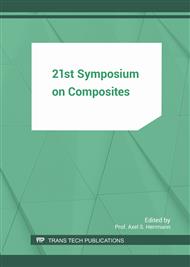p.374
p.381
p.389
p.395
p.401
p.408
p.419
p.427
p.434
Aspects of Preloaded Bolted Joints of Fiber Reinforced Polymers and Metals
Abstract:
To join components of fiber reinforced polymers (FRP) to metals or FRP, too, bolted joints are used regularly. Reliability, affordability, and disassembly are the drivers for dissemination of this joining technique; despite some disadvantages. For bolted joints of metals it is well known, that a preloading of the bolts increases the efficiency drastically. Therefore, preloaded screws are the standard in mechanical engineering. Prerequisite is a load transfer by friction of the joining partners induced by a preload of the bolt. However, when joining FRP components a preloading of the bolts is usually not considered since a force release is afraid due to creeping of the polymeric matrix. Furthermore, the load transfer by friction of FRP is not investigated sufficiently. The limiting parameters of preloaded bolted joints of different FRP materials are investigated here. Particularly these are the allowed contact pressure at the bolt heads or washers, the coefficient of friction in the joining zone, and the release behavior of the preloading. The load transfer capability of bolted joints under optimized conditions is presented.
Info:
Periodical:
Pages:
401-407
Citation:
Online since:
July 2017
Authors:
Keywords:
Price:
Сopyright:
© 2017 Trans Tech Publications Ltd. All Rights Reserved
Share:
Citation:


